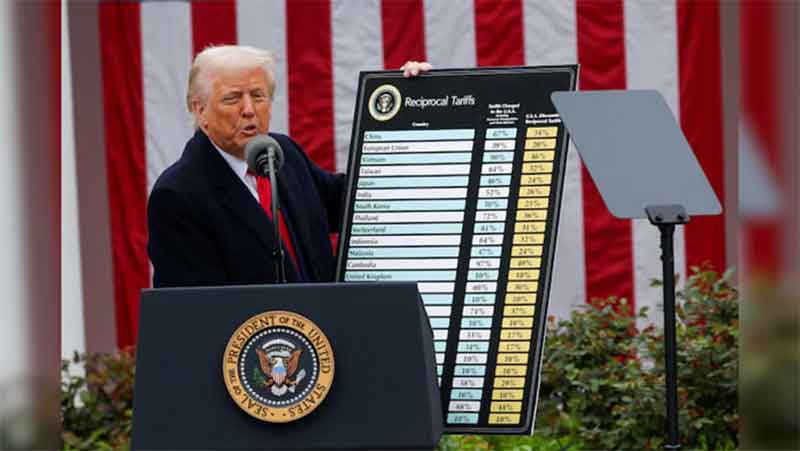
The combined tariff of fifty percent on Indian exports to the United States imposed by President Donald Trump should not come as a surprise, despite India’s undefined and directionless strategic partnership with the U.S. Indian liberals and their right-wing counterparts had celebrated this so-called strategic partnership with the United States. However, from technological embargoes to trade barriers, this steep tariff reflects a historical continuity of anti-India foreign policy pursued by the U.S. America was never, is not, and likely will never be a true friend to a developed and sovereign India. It has consistently pursued various forms of strategic foreign policy aimed at undermining India’s strength and independence. American racial capitalism and its ruling elites are fundamentally opposed to the idea of an independent and developed India.
Even the much-touted food aid under U.S. Public Law 480 (PL-480)—ironically referred to as “American 420 food supply” by some—while it helped alleviate food shortages in India during the 1950s, was also strategically designed to undermine India’s food sovereignty. By initially dumping surplus American agricultural products, it aimed to create a dependency and eventually open up India as a market for U.S. food exports. India’s response, however, came through the establishment of a universal and integrated Public Distribution System (PDS). This system not only laid the foundation for the Green Revolution but also strengthened the country’s food sovereignty, particularly with the rise of Food Corporation of India (FCI) storehouses. It played a major role for the production, storage and consistent supply for food to poor and ensuring food security for all. The PDS ensured a minimum support price for producers, incentivised foodgrain production, and guaranteed a steady food supply to consumers, thereby promoting long-term food security. This state-led intervention ultimately countered the U.S. strategy that sought to make India dependent on American agriculture and food corporations.
The 1991 New Economic Reform programs initiated by the Congress Party were further deepened by the BJP, weakening both agriculture and food security in India by revamping and targeting the Public Distribution System (PDS). The rural agrarian crisis that India is experiencing today is a direct outcome of these reform measures implemented by both the Congress and the BJP. The fifty percent tariff on Indian exports is a bullying tactic by the American ruling class, intended to pressure India into further liberalising its agricultural sector. This would open up the internal food market to American food corporations, thereby strengthening U.S. agriculture at the expense of India’s agrarian economy and the livelihoods of its farmers and agricultural workers. So, the opposition to this American strategy is therefore essential to safeguarding the interests of the Indian working people.
America ruling classes have consistently supported illiberal and reactionary forces in Asia to undermine anti-colonial, anti-imperialist, and anti-capitalist movements, ultimately weakening the foundations of democracy in the region. It has formed alliances with authoritarian and undemocratic regimes to protect and advance its own strategic interests. The current strategy of weakening India is not new; the United States has pursued similar policies since Indian independence. American foreign policy has long aimed to destabilise Asia by promoting conflicts between nations—India and Pakistan, India and China, and even India and Bangladesh. From manufacturing terrorism and destabilising Afghanistan to backing the Pakistani military—which has repeatedly dismantled democracy within Pakistan and fuelled terrorism and hostilities with India—these actions are rooted in American imperialism. The recent imposition of tariffs reflects America’s broader intent to contain the rise of India, China, and a peaceful, cooperative, and harmonious Asia.
The American alibi of justifying the imposition of higher tariff and criticising India’s friendship with Russia—particularly its purchase of Russian oil and military equipment—is a strategic move aimed at weakening India. This is despite the fact that the U.S. itself imported goods worth approximately US$3.27 billion from Russia in 2024. While preaching that India and other nations should stop purchasing Russian goods in the name of not funding the war in Ukraine, the U.S. continues to engage in trade with Russia when it suits its own interests.
In reality, India has opposed the conflict in uncertain terms and has consistently called for a diplomatic and peaceful resolution between Russia and Ukraine. However, the Yankee imperialists in Europe, led by the United States, seem intent on prolonging the war—not to defend Ukraine, but to weaken Russia and suppress civil liberties across Europe by invoking a perpetual “extraordinary situation” caused by the conflict. Ironically, President Donald Trump, who once promised to end the war during his election campaign, is now fuelling it further to revive America’s defence industry. The American ruling elite is dragging India into this project by pressuring it to purchase U.S. defence equipments. The imposition of higher tariffs on Indian exports is part of this arm-twisting strategy, aimed at disrupting the historic and time-tested Indo-Russian partnership, which Washington views as a threat to its global dominance.
Similarly, the United States is attempting to escalate the limited border conflict between India and China by promoting the idea of an “Asian NATO” under the guise of advancing the Quadrilateral Security Dialogue (QUAD). While presented as a strategy to contain China, this framework ultimately aims to control and constrain India as well. It is crucial to expose such American imperialist strategies, in which U.S. interests remain paramount in all strategic engagements and partnerships, often at the expense of regional peace, autonomy and sovereignty. India must recognize these tactics and consider bold steps—including reducing dependency on American trade and mobilising its own internal resources and diversifying its international trade—to safeguard its economic and military sovereignty, which is increasingly under threat from American geopolitical manoeuvring.
The fall of Soviet Union and weakening of Non Allied Movement (NAM) are two defining events that allows American imperialism to continue its unchecked hegemony which has destroyed stable countries, secular societies and viable economic systems in Middle East, Africa, Asia, Americas and Europe to protect US interests. The worldwide failure of capitalism and weakening of American imperialism makes American ruling elites to fall on their time tested strategy of fuelling global crisis by promoting regional conflicts, terrorism and economic warfare to reestablish itself as unchallenged global police. African, Asian, and Latin American countries are increasingly challenging American hegemony. In response, the United States is resorting to aggressive trade policies and tariff barriers to contain their economic rise. India must recognise and expose these regional strategies pursued by the U.S. while working to build anti-imperialist global alliances. Such alliances are essential not only to protect India’s own people and national interests but also to support freedom-loving, peace-seeking democratic populations across the world.
From agriculture, industry to technology, India has the capacity to mobilise its own internal resources, strengthen regional partnerships, and diversify its international business, trade and economic relations to recover from the strategic missteps and costs of aligning too closely with Yankee imperialism under the guise of a “strategic partnership.” Any compromise or surrender to American pressure will not only undermine India’s sovereignty and development but also weaken the broader global movement toward democratisation and multipolarity of world politics and economy. Therefore, India must stand firm and uphold its historic anti-imperialist legacy to protect and promote universal peace, justice, and harmony.
